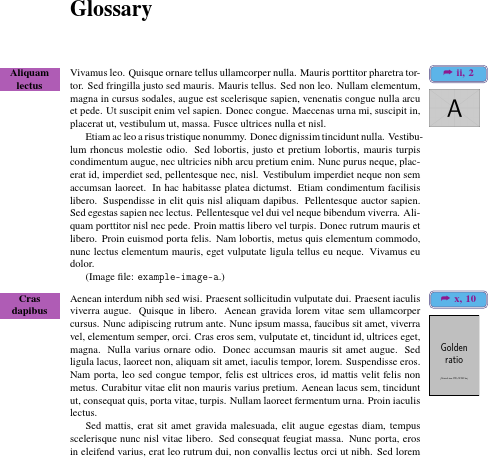Gallery: Adjusting the alttree Style
This example uses the glossaries-extra
package, which extends the glossaries package and provides
better abbreviation handling.
This is quite a complicated example. It uses the
tikz
package to add a splash of colour to the name and location list. The
location list is formatted according to
\GlsXtrFormatLocationList (which takes the location
list as the argument). This is redefined so that it
typesets the locations in Plum after a curving arrow. This requires
locally hiding the hyperlinks so that the link colour doesn’t
override the text colour:
\renewcommand*{\GlsXtrFormatLocationList}[1]{%
{% localise
\hypersetup{hidelinks}%
\textcolor{Plum}{\ding{230}~\textbf{#1}}%
}%
}
The default top level indent is suppressed so that the description
takes up the text width. This is done by setting
\glsxtrtreetopindent to 0pt. The width of the maximum
location list is computed and stored in \maxlocwidth
and an extra 1em is added to provide a little padding. This is only
suitable for short location lists that can fit on a single line.
These lengths are all set by \glsxtralttreeInit.
\newlength\maxlocwidth
\renewcommand*{\glsxtralttreeInit}{%
% setup lengths
\glsFindWidestAnyNameLocation[\currentglossary]%
{\maxlocwidth}%
\setlength{\glsxtrtreetopindent}{0pt}%
\addtolength{\maxlocwidth}{1em}%
\glsxtrAltTreeIndent=\parindent
}
The name is formatted according to \glstreenamebox.
This is redefined to protrude out into the left margin and the
contents are placed inside a tikz node to give it an Orchid
rectangular background. Note that here the new definition
of \glstreenamebox ignores its first argument as
instead it uses \namewidth to determine its width.
\newlength\nameinnersep
\nameinnersep=2pt
\newlength\nameoutersep
\nameoutersep=2pt
\newlength\namewidth
\namewidth=1in
\renewcommand*{\glstreenamebox}[2]{%
\makebox[\namewidth][r]%
{%
\smash{%
\begin{tikzpicture}[baseline=(X.base)]
\node[fill=Orchid,
align=center,
text width=\dimexpr\namewidth-2\nameinnersep-2\nameoutersep,
inner sep=\nameinnersep,
outer sep=\nameoutersep
] (X) {#2};
\end{tikzpicture}%
}%
\quad
}%
}
This document uses the dummy entries defined in the sample
file example-glossaries-images.tex, which is provided with
the glossaries package. These entries have multi-paragraph
descriptions, and some of the entries use the user1 key
to store the name of an associated image file. These are just the
dummy image files provided by the
mwe package.
A command is provided to format text (which will be the location list) in a blue box with rounded corners:
\newcommand*{\locbox}[1]{%
\begin{tikzpicture}[baseline=(X.base)]
\node[text width=\maxlocwidth,
draw=CadetBlue,
fill=CornflowerBlue,
double,
thick,
align=center,
rounded corners]
(X) {#1};
\end{tikzpicture}%
}
The aim here is to place the location list in the right margin
(which can be done with \marginpar) and below that the
image (if one has been provided). This can be done with another
\marginpar, but this can lead to the image dangling
into the footer if there’s not enough room for it. The available
space needs to be calculated. This depends on
\pagegoal, \pagetotal and the height of
the image, so the image is first saved in a box and its height is
calculated. If there’s not enough space, the image is deferred until
the next page (using \afterpage provided by the
afterpage package).
This could still potentially lead to a problem where there’s
insufficient room for it on the next page, but, in this example, the
descriptions are all long enough for this not to be a problem.
\newsavebox\imagebox
\newlength\tmplen
\newlength\imgheight
\newcommand{\deferredimage}{%
\marginpar{\usebox\imagebox}%
}%
\newsavebox\slocbox
\newlength\locboxheight
\renewcommand{\glsxtralttreeSymbolDescLocation}[2]{%
\sbox\slocbox{\locbox{#2}}%
\settodepth{\tmplen}{\usebox\slocbox}%
\settoheight{\locboxheight}{\usebox\slocbox}%
\advance\locboxheight by \tmplen
\marginpar{\usebox\slocbox}%
\ifglshasfield{useri}{#1}%
{%
\sbox\imagebox{\includegraphics[width=\maxlocwidth]{\glsentryuseri{#1}}}%
\settoheight{\imgheight}{\usebox\imagebox}%
\setlength{\tmplen}{\dimexpr\pagegoal-\pagetotal-\imgheight-\locboxheight}%
\relax
\ifdim\tmplen<0pt\relax
\afterpage{\deferredimage}%
\else
\marginpar{\usebox\imagebox}%
\fi
}%
{}%
% scope \par change
{%
\let\par\glsxtrAltTreePar
\glossentrydesc{#1}\glspostdescription\par
(Image file:
\ifglshasfield{useri}{#1}{\texttt{\glsentryuseri{#1}}}{none}.)\par
}%
\indexspace
}
At the end of the above definition, \indexspace is added to provide a little visible separation between each
entry, otherwise it looks too cluttered, especially with no
paragraph indent at the start of the description. The intergroup space is
suppressed using the nogroupskip package option.
The initial comment lines below are arara directives. You can remove them if you don’t use arara.
% arara: pdflatex
% arara: makeglossaries if found("aux", "@istfilename")
% arara: pdflatex
\documentclass[12pt]{report}
\usepackage[a4paper,left=1.5in,marginpar=70pt]{geometry}
\usepackage[T1]{fontenc}
\usepackage{tgtermes}
\usepackage[dvipsnames]{xcolor}
\usepackage{pifont}
\usepackage{tikz}
\usepackage{afterpage}
\usepackage[colorlinks]{hyperref}
\usepackage[stylemods=tree,style=alttree,nogroupskip,ucmark,savenumberlist]{glossaries-extra}
\makeglossaries
\loadglsentries{example-glossaries-images}
\glssetcategoryattribute{general}{glossname}{firstuc}
\renewcommand*{\GlsXtrFormatLocationList}[1]{%
{%
\hypersetup{hidelinks}%
\textcolor{Plum}{\ding{230}~\textbf{#1}}%
}%
}
\newlength\maxlocwidth
\renewcommand*{\glsxtralttreeInit}{%
% setup lengths
\glsFindWidestAnyNameLocation[\currentglossary]%
{\maxlocwidth}%
\setlength{\glsxtrtreetopindent}{0pt}%
\addtolength{\maxlocwidth}{1em}%
\glsxtrAltTreeIndent=\parindent
}
\newlength\nameinnersep
\nameinnersep=2pt
\newlength\nameoutersep
\nameoutersep=2pt
\newlength\namewidth
\namewidth=1in
\renewcommand*{\glstreenamebox}[2]{%
\makebox[\namewidth][r]%
{%
\smash{%
\begin{tikzpicture}[baseline=(X.base)]
\node[fill=Orchid,
align=center,
text width=\dimexpr\namewidth-2\nameinnersep-2\nameoutersep,
inner sep=\nameinnersep,
outer sep=\nameoutersep
] (X) {#2};
\end{tikzpicture}%
}%
\quad
}%
}
\newcommand*{\locbox}[1]{%
\begin{tikzpicture}[baseline=(X.base)]
\node[text width=\maxlocwidth,
draw=CadetBlue,
fill=CornflowerBlue,
double,
thick,
align=center,
rounded corners]
(X) {#1};
\end{tikzpicture}%
}
\newsavebox\imagebox
\newlength\tmplen
\newlength\imgheight
\newcommand{\deferredimage}{%
\marginpar{\usebox\imagebox}%
}%
\newsavebox\slocbox
\newlength\locboxheight
\renewcommand{\glsxtralttreeSymbolDescLocation}[2]{%
\sbox\slocbox{\locbox{#2}}%
\settodepth{\tmplen}{\usebox\slocbox}%
\settoheight{\locboxheight}{\usebox\slocbox}%
\advance\locboxheight by \tmplen
\marginpar{\usebox\slocbox}%
\ifglshasfield{useri}{#1}%
{%
\sbox\imagebox{\includegraphics[width=\maxlocwidth]{\glsentryuseri{#1}}}%
\settoheight{\imgheight}{\usebox\imagebox}%
\setlength{\tmplen}{\dimexpr\pagegoal-\pagetotal-\imgheight-\locboxheight}%
\relax
\ifdim\tmplen<0pt\relax
\afterpage{\deferredimage}%
\else
\marginpar{\usebox\imagebox}%
\fi
}%
{}%
% scope \par change
{%
\let\par\glsxtrAltTreePar
\glossentrydesc{#1}\glspostdescription\par
(Image file:
\ifglshasfield{useri}{#1}{\texttt{\glsentryuseri{#1}}}{none}.)\par
}%
\indexspace
}
\pagestyle{headings}
\begin{document}
\pagenumbering{roman}
\chapter*{Front Matter Test}
\forallglsentries{\thislabel}{\gls{\thislabel}.\newpage}
\pagenumbering{arabic}
\chapter{Main Matter Test}
\forallglsentries{\thislabel}{\gls{\thislabel}.\newpage}
\printglossaries
\end{document}
If you don’t use arara, you need to run the following commands:
pdflatex alttree-marginpar makeglossaries alttree-marginpar pdflatex alttree-marginpar
(See Incorporating makeglossaries or makeglossaries-lite or bib2gls into the document build.)
Download: PDF (198.68K), source code (2.95K), sample glossary definitions (14.11K).

